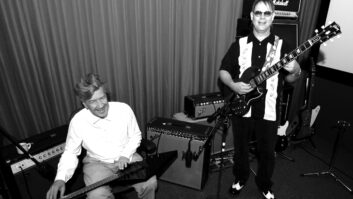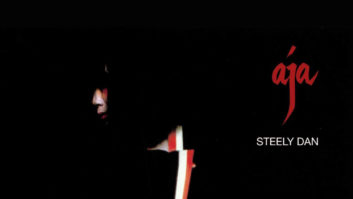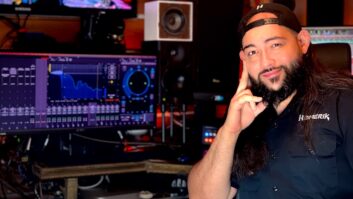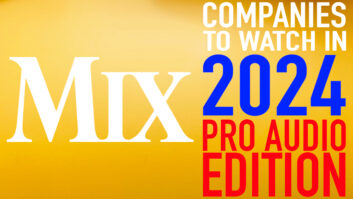
Keeping an eye on Steely Dan’s sound were (l-r):
Tom LeBouf, systems tech; Mark Dowdle, FOH engineer; and Peter Thompson, monitor engineer.
Steely Dan may be best-known in pro-audio circles for its impeccably recorded albums, but recent years saw the duo make its presence known mostly on the road. In remembrance of co-founder Walter Becker, who died September 3, we look back here at the band’s 2013 Mood Swings tour in this article from our February, 2014 issue. What did it take to reproduce that perfect studio sheen live—and, since the whole world uses Steely Dan songs to check PAs, what did Steely Dan’s PA get tuned with? Read on and find out.
In the public’s view, Steely Dan has always been about impeccable jazz rock, tastefully arranged and often laced with cyanide lyrics. That singular sound has sold more than 40 million albums and spawned radio touchstones like “Peg,” “Reelin’ In The Years” and “F.M.,” to name just a few.
For the pro audio community, however, the vaunted duo’s studio work has an even greater reputation, widely revered as some of the most pristinely recorded music ever. Bringing the band’s sound to the stage, then, was an all-the-more daunting task for the audio team on the group’s recent “Mood Swings” tour. It’s standard practice for live engineers to try and make a show sound like the album, but when you’re talking about Steely Dan, that’s a bigger challenge than usual.
It was all in a day’s work, however, for FOH man Mark Dowdle on the recent cross-country journey. Running from summer well into fall, and concluding with an eight-night stand at New York City’s Beacon Theatre, the production carried a full audio system from Thunder Audio (Livonia, MI/Nashville, TN).
The group performed entire albums on different nights of the tour, stopping midway through each for a visual gag where they’d visit an onstage phonograph and flip the LP over for side two. With that kind of emphasis on analog, perhaps it’s no surprise to find there was little in the way of digital gear at FOH.
Dowdle oversaw a 56-input Midas XL4 console with three extra stereo modules for use in specific parts of the show, handling keyboards, stereo keyboards and different overheads. “I’ve spent a lot of time on all the new digital boards,” said Dowdle, “and I can’t find anything other than a Midas XL8 or Midas products that give me the kind of musical analog quality that I get from this. Also, it was also Donald and Walter’s requirement that I use analog, so it made the choice very easy to go with an XL4.”
In keeping with the band’s studio sound, the mix stayed on the dry side, going light on the effects. “I’ve got a Lexicon 960L that I use on Donald [Fagan]’s vocal and the background vocals,” he said. “There’s an AMS RMX 16 used on the drums, a TC Electronic M5000 for the horn reverb and I have a TC 2290 for any delays, but they’re minimal with this situation—I’m only using the delay on one or two songs.”
Of course, all that gear would be for naught if the signal going through it sounded bad. Good sound always starts with good mics, and there was a wide variety to be found on the Steely Dan stage, ranging from standard-issue Shures and Sennheisers to unreleased Telefunkens to road-worthy ribbon mics.
“I tend to build everything around the drums,” Dowdle explained. “Once I have that the way I want it, everything seems to fall into place for me, so using the Telefunken C12s on overheads have been integral in achieving the kind of drum sound that I’m looking for. I can’t even begin to say enough about what it does for the sound of the drums and the sound overall. We’re also beta-testing a Telefunken mic called the M60 FET. It’s kind of the equivalent or better than the AKG 451, and I use that on the ride cymbal and a high hat. They also have a new kick mic, the M82, which we have on the kick and the bass; It’s a front address mic, interior shock-mounted, and does a really great job. I’ve got Sennheiser 906s on the toms; Shure 57 on the snare top and Beta 56 on the bottom, some new 87s, and SM7s on Walter [Becker]’s guitars. We have AEA R84 and KU4 ribbon mics on the horns, and then we have Telefunken M80s on the background vocals, and Donald’s using an Earthworks SR40V. He’s been using those on his vocal for quite some time, so we just stuck with that.”
As Elton John’s longtime FOH engineer—other credits include Gloria Estefan, Fleetwood Mac and Jackson Browne—Dowdle knows a little something about miking a piano, but he’s not above trying something new: “Normally on Elton and other things that I’ve done, I’ll use two AKG 414s in a cardioid pattern flat. This time, I thought, ‘OK, let me try this,’ and I put one in a figure 8 and turned it on its side, so it would go both directions, up and down, on the high side of the piano. I built a little bridge with a dip in it, put the mic in there, secured it in with Velcro and it seems to be working pretty well—but it’s kind of an odd configuration compared to any other piano miking I’ve done previously. There’s also a couple Earthworks mics in there and a Helpinstill.”
For the final eight-night stand at the Beacon Theatre, the production used the house PA of QSC-powered JBL VerTec 8988 arrays, but for the rest of the journey, the band was heard via a d&b audiotechnik J-series line array sub-rented from Eighth Day Sound (Highland Heights, OH).
Steely Dan’s late 1970s output, labored over in the studio by the band and legendary engineers Roger Nichols and Elliot Scheiner, is still revered decades later—so much so that engineers everywhere continue to use those albums and Donald Fagen’s solo debut, The Nightfly, as go-to recordings to play while tuning a PA. So if everyone uses Steely Dan, what does a Steely Dan tour use?
“I’ve been tuning PAs all over the world with Steely Dan songs for almost 40 years,” said Dowdle with a chuckle, “but I chose not to do that on this gig—you know, just didn’t seem quite like the thing to do! I use a couple of things: Thomas Dolby’s Aliens Ate My Buick—there’s a cut on there called ‘My Brain is Like a Sieve’—and then I also use a cut off Frank Zappa’s Joe’s Garage, ‘Lucille.’ That has a great, very natural sounding vocal, and that helps me get the PA close to where I want it. But primarily I use a microphone and talk through the PA. Every record’s mixed differently, every cut is going to have a different frequency response, none of them are going to be the same, and to think that they’re going to give you exactly what you need in a specific room? It’s not going to happen—but a microphone’s consistent, it’s going to be the same every time you talk into it, and as far as I’m concerned, it’s the best way to voice a PA.”
The result was that Dowdle had a clean palette to work with, creating a mix nightly that would properly convey the music being created. “I want to ensure pristine audio quality,” he said. “I aim for everything on the stage to be heard at all times and heard in a way where it’s full, rich and natural sounding—and very musical. For instance, I like mixing ‘Black Cow’ because it has a lot of openness and I’m able to get a lot of definition on the nuances that are going on. ‘Bodhisattva’ is more up-tempo, but more challenging because of the amount of things that are happening from moment to moment.”
Meeting that challenge and making it sound as perfect as possible was fine with Dowdle, and in a way, perhaps it was karmic payback to handle the sound for the act that first piqued his interest in audio years ago: “Oddly enough, the two principles in this band, Donald and Walter, were the inspiration for me to do what I do. Having grown up during the beginning of their career, they were always a favorite of mine when it came to listening quality of music. Their vision and approach to recording, I just found interesting and inspiring, and that’s really what started me down this road; these guys were quite an influence.”
Thunder Audio, Inc.
Thunderaudioinc.com
Midas
Midasconsoles.com







